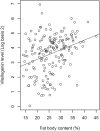A 'Landscape physiology' approach for assessing bee health highlights the benefits of floral landscape enrichment and semi-natural habitats
- PMID: 28084452
- PMCID: PMC5234012
- DOI: 10.1038/srep40568
A 'Landscape physiology' approach for assessing bee health highlights the benefits of floral landscape enrichment and semi-natural habitats
Abstract
Understanding how anthropogenic landscape alteration affects populations of ecologically- and economically-important insect pollinators has never been more pressing. In this context, the assessment of landscape quality typically relies on spatial distribution studies, but, whether habitat-restoration techniques actually improve the health of targeted pollinator populations remains obscure. This gap could be filled by a comprehensive understanding of how gradients of landscape quality influence pollinator physiology. We therefore used this approach for honey bees (Apis mellifera) to test whether landscape patterns can shape bee health. We focused on the pre-wintering period since abnormally high winter colony losses have often been observed. By exposing colonies to different landscapes, enriched in melliferous catch crops and surrounded by semi-natural habitats, we found that bee physiology (i.e. fat body mass and level of vitellogenin) was significantly improved by the presence of flowering catch crops. Catch crop presence was associated with a significant increase in pollen diet diversity. The influence of semi-natural habitats on bee health was even stronger. Vitellogenin level was in turn significantly linked to higher overwintering survival. Therefore, our experimental study, combining landscape ecology and bee physiology, offers an exciting proof-of-concept for directly identifying stressful or suitable landscapes and promoting efficient pollinator conservation.
Figures




References
-
- Biesmeijer J. C. et al. Parallel declines in pollinators and insect-pollinated plants in Britain and the Netherlands. Science 313, 351–354 (2006). - PubMed
-
- Goulson D., Nicholls E., Botias C. & Rotheray E. L. Bee declines driven by combined stress from parasites, pesticides, and lack of flowers. Science 347, 1255957 (2015). - PubMed
-
- Ollerton J., Erenler H., Edwards M. & Crockett R. Extinctions of aculeate pollinators in Britain and the role of large-scale agricultural changes. Science 346, 1360–1362 (2014). - PubMed
-
- Winfree R., Bartomeus I. & Cariveau D. P. Native Pollinators in Anthropogenic Habitats. Ann Rev Ecol Evol Syst 42, 1–22 (2011).
-
- Potts S. G. et al. Global pollinator declines: trends, impacts and drivers. Trends Ecol Evol 25, 345–353 (2010). - PubMed
Publication types
MeSH terms
Substances
LinkOut - more resources
Full Text Sources
Other Literature Sources
Miscellaneous

